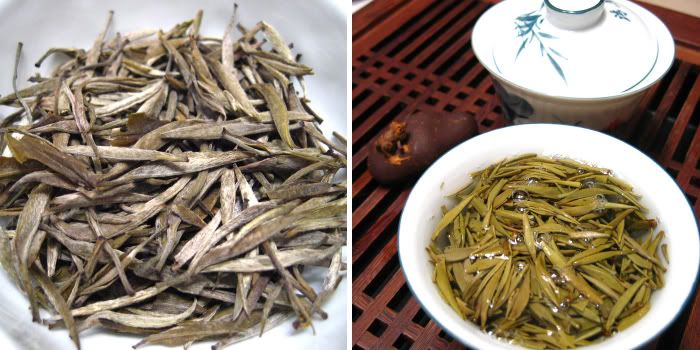As with many Chinese tea names, the preceding words/characters refer to the place of origin and then followed by the tea’s name or type. In this case, Jun Shan Yin Zhen simply means Silver Needle of Mount Jun, which is located near Lake Dong Ting in the Hunan Province of China.
Supposedly, Jun Shan Yin Zhen is the rarest, most famous, most valuable (read: very expensive), and the best of all yellow teas. According to Master Lam Kam Chuen in his book “The Way of Tea,” this tea was popular during the Tang Dynasty but rarely drunk nowadays. Master Lam also noted:
"One of the reasons it is so famous is because when you make the tea the leaves stand vertically: some stand at the surface catching air bubbles while others stand at the bottom of the cup. According to Japanese superstition, tea leaves that stand vertically signify good luck."Some retailers claim that this was the favorite drink of the late Chairman Mao Zedong and that it was an imperial tribute tea for the emperors back in the ancient China days. I wonder if this is entirely true or just a marketing gimmick not unlike how tabloid magazines market some products (“Julia Roberts uses this facial cream!”).
Ok, enough background. How does it taste?
Knowing that yellow tea is delicate, it is therefore sensitive to brewing method and parameters. For this session, I used a 6oz gaiwan filled with about 1/4 of dry leaves and 75-80 degree Celsius spring water. Brewing time was: 30s, 30s, 40s, 50s…
Light clear yellow with a hint of amber/orange in color. Nose is of light and delicate white flower. Quite monotonic, I must say, but this does not mean the tea itself is “bad.” This is properly a yellow tea’s taste. Quite tannic, surprisingly, for such a light tea. At first, it seemed to taste like nothing but the spring water I brewed it with. A few seconds later, however, I realized that it’s actually slightly sweet and refreshing. It leaves a long lasting aftertaste that seems to go on forever everywhere in the mouth and the back of the throat. Although it’s been about an hour since I finished my last cup, I still could taste the sweetness in my mouth and throat. The tea leaves when chewed on is bitter-sweet.
This tea is perfect for relaxation. It is a nice change of pace for me after a few days of young raw pu-erh, cooked pu-erh, dan cong, and qing xiang tie guan yin. However, I’m still not quite sure what a good yellow tea should taste like, so it’s hard to judge. Do I like this tea? Yes, I do.

5 comments:
yellow tea is made by a hot withering stag before final drying that's why its yellow. it is not made that much and is expensive because it is not known by most therefore it is made rarely, the best time to make it is in april i think when the humidity and temp. is right, but i could be mistaken about the date. it would still be a little expensive but not as much if it is in demand one day.....
---icetea
http://teaarts.blogspot.com/
Thank you for the information, icetea.
Ooph, I could be wrong, but I suspect you got fake Yin Zhen. You might take a look at the description of it at teaspring.com (there are a lot of fakes out there posing as the much more expensive real thing - I don't know of any silver needle that should cost that much).
I have two types in my cupboard, the yellow tea and one that looks exactly like what you pictured (more like a white tea, or at least that's how I classify it). The yellow has no visible white hairs, except when you look very closely, particularly to the wet leaf. Otherwise it looks a lot like a green tea, which a yellow is much closer to. The real stuff has an elusive but penetrating spicy smokiness that is fleeting and remains at the top of your palate. It can be hard to get, but it's definitely there. The more obvious silver needle has a much smoother and sweeter character. The spicyness is there, but only like a dim shadow of what it should be.
I'm working on another review right now, but was planning to do a review on this one anyway, so perhaps I will try to do so later today or tomorrow. I'll include pictures of both and the info I got from TeaSpring about it when I asked.
Jun Shan Yin Zhen is processed in three different ways: the "new" way, smoked, and the "traditional" way. Teaspring carries the highest grade of the "new" processed Jun Shan Yin Zhen; I believe the "traditional" processed is the most expensive. So it's entirely possible that the tea being reviewed isn't fake--just different.
Hell the real stuff I used to grow in China was great, my family only had one tree and they would pick from the tree and fry it a bit in a dry wok in order to give it that aroma.
I'm pretty sure the tree is gone now ever since urbanisation of the area I used to live in, however my house is still near the top of the mountain.
Post a Comment